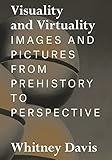Visuality and Virtuality : Images and Pictures from Prehistory to Perspective / Whitney Davis.
Material type: TextPublisher: Princeton, NJ : Princeton University Press, [2022]Copyright date: ©2018Description: 1 online resource (368 p.)Content type:
TextPublisher: Princeton, NJ : Princeton University Press, [2022]Copyright date: ©2018Description: 1 online resource (368 p.)Content type: - 9780691245904
- Visual perception in art
- ART / Criticism
- 3D modeling
- A Book Of
- Abraham Cahan
- Abstract art
- Accessibility
- Aesthetics
- Allegation
- Ambiguity
- Analytic geometry
- Art history
- Athens
- Autobiography
- Autodidacticism
- Awareness
- Axial line (dermatomes)
- Baptistery
- Bibliography
- Classical Greece
- Coincidence
- Consciousness
- Copyright
- Critique
- Cupola
- David Marr (neuroscientist)
- Depiction
- Designer
- Diadumenos
- Diagram
- Direct evidence
- Disability
- Donald Judd
- Doryphoros
- Ecology
- Edith Hamilton
- Egyptology
- Explication
- Forgiveness
- Grapheme
- Group dynamics
- Harry Burleigh
- Henry David Thoreau
- Horizontal plane
- Ida B. Wells
- Illustration
- Johann Wolfgang von Goethe
- Kilt
- Lecture
- Life Story (TV series)
- Literary criticism
- Medical diagnosis
- Melville J. Herskovits
- Microscopy
- Misconduct
- Modernity
- Musician
- Nationality
- Neurocognitive
- Ontology
- Optical resolution
- Orthographic projection
- Paleoanthropology
- Perception
- Pericles
- Perspective (graphical)
- Pictorialism
- Piero della Francesca
- Plaquette
- Poetry
- Polykleitos
- Prehistory
- Proportion (architecture)
- Rectangle
- Relief
- Retina
- Rhetoric
- Scapula
- Scrovegni Chapel
- Scrutiny (journal)
- Serdab
- Sightline
- Social environment
- Soffit
- Software
- Spatial distribution
- Spatial relation
- Stanley Kubrick
- Stephen Crane
- Stylobate
- Subject (philosophy)
- Subtitle (captioning)
- The Ass in the Lion's Skin
- The Textbooks
- Thunderstorm
- Trompe-l'œil
- Visual culture
- Visual field
- Visual space
- Vitruvian Man
- World Archaeology
- Zoology
- 701/.18 23
- online - DeGruyter
| Item type | Current library | Call number | URL | Status | Notes | Barcode | |
|---|---|---|---|---|---|---|---|
 eBook
eBook
|
Biblioteca "Angelicum" Pont. Univ. S.Tommaso d'Aquino Nuvola online | online - DeGruyter (Browse shelf(Opens below)) | Online access | Not for loan (Accesso limitato) | Accesso per gli utenti autorizzati / Access for authorized users | (dgr)9780691245904 |
Browsing Biblioteca "Angelicum" Pont. Univ. S.Tommaso d'Aquino shelves, Shelving location: Nuvola online Close shelf browser (Hides shelf browser)

|

|

|

|

|

|

|
||
| online - DeGruyter Houses and Society in Pompeii and Herculaneum / | online - DeGruyter Face and Mask : A Double History / | online - DeGruyter Marketing Maximilian : The Visual Ideology of a Holy Roman Emperor / | online - DeGruyter Visuality and Virtuality : Images and Pictures from Prehistory to Perspective / | online - DeGruyter Weak Strongman : The Limits of Power in Putin's Russia / | online - DeGruyter Wright on Exhibit : Frank Lloyd Wright's Architectural Exhibitions / | online - DeGruyter Houses for a New World : Builders and Buyers in American Suburbs, 1945–1965 / |
Frontmatter -- CONTENTS -- PREFACE -- A NOTE ON NOTATIONS AND ABBREVIATIONS -- INTRODUCTION Images and Pictures -- PART ONE Analytics of Imaging Pictures in Visual Space -- CHAPTER ONE Visuality and Virtuality: Analytics of Visual Space and Pictorial Space -- CHAPTER TWO Radical Pictoriality: Seeing-As, Seeing-As-As, Seeing-As-As-As… -- CHAPTER THREE What the Chauvet Master Saw: On the Presence of Prehistoric Pictoriality -- PART TWO Bivisibility, Bivirtuality, and Birotationality -- CHAPTER FOUR Bivisibility: Between the Successions to Visuality -- CHAPTER FIVE Bivirtuality: Pictorial Naturalism and the Revolutions of Rotation -- CHAPTER SIX Birotationality: Frontality, Foreshortening, and Virtual Pictorial Space -- PART THREE Pictorial Successions of Virtual Coordinate Space -- CHAPTER SEVEN What Hesire Saw: Virtual Coordinate Space in Ancient Egyptian Depiction -- CHAPTER EIGHT What Phidias Saw: Virtual Coordinate Space in Classical Greek Architectural Relief -- CHAPTER NINE What Brunelleschi Saw: Virtual Coordinate Space and Painter’s Perspective -- NOTES -- INDEX -- ILLUSTRATION CREDITS
restricted access online access with authorization star
http://purl.org/coar/access_right/c_16ec
A provocative and challenging new conceptual framework for the study of imagesThis book builds on the groundbreaking theoretical framework established in Whitney Davis’s acclaimed previous book, A General Theory of Visual Culture, in which he shows how certain culturally constituted aspects of artifacts and pictures are visible to informed viewers. Here, Davis uses revealing archaeological and historical case studies to further develop his theory, presenting an exacting new account of the interaction that occurs when a viewer looks at a picture.Davis argues that pictoriality—the depiction intended by its maker to be seen—emerges at a particular standpoint in space and time. Reconstruction of this standpoint is the first step of the art historian’s craft. Because standpoints are inherently mutable and mobile, pictoriality constantly shifts in form and possible meaning. To capture this complexity, Davis develops new concepts of radical pictorial ambiguity, including “bivisibility” (the fact that pictures can always be seen in ways other than intended), pictorial naturalism, and the behavior of pictures under changing angles of view. He then applies these concepts to four cases—Paleolithic cave painting; ancient Egyptian tomb decoration; classical Greek architectural sculpture, with a focus on the Parthenon frieze; and Renaissance perspective as invented by Brunelleschi.A profound new theory of the work of both makers and viewers by one of the discipline’s most esteemed and engaged thinkers, Visuality and Virtuality is essential reading for art historians, architects, archaeologists, and philosophers of art and visual theory.
Mode of access: Internet via World Wide Web.
In English.
Description based on online resource; title from PDF title page (publisher's Web site, viewed 27. Jan 2023)


